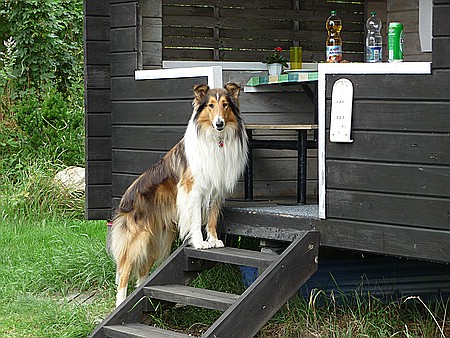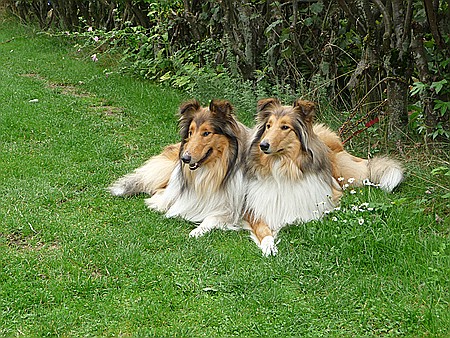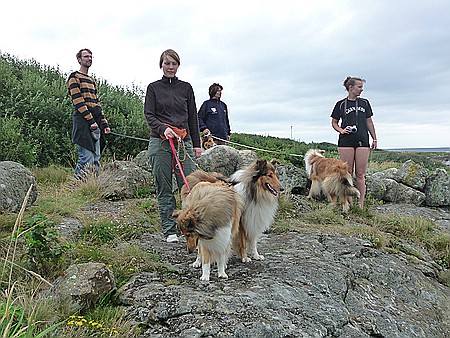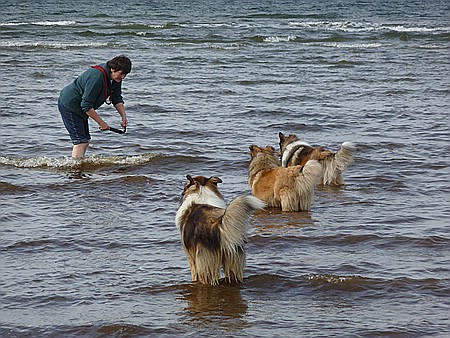Journey to Sweden for
the mental description at the Swedish working dog club
Swedish collie breeders invited Christine Erdmann and me to participate
actively with our young dogs in a dog event of mental description
organised by the Swedish working dog club.
Then the 14th of August 2010 was fixed as the date for the event which
was to take place on the dog sports ground in Falkenberg (south of
Sweden), located at the Baltic Sea.
In preparation for our previous journeys I found out that it is possible
to receive very useful information at the city information by e-mail
or mail.
We booked the ferry from Rostock and two cabins on the outskirts of
Falkenberg, only a few hundred metres from the dog-field. We had carried
out the necessary rabies regulations for the one and a half years
old dogs in good time. Not later than ten days before the departure
to Sweden a veterinary surgeon has to confirm that the dog has received
an anthelmintic therapy and a treatment against ticks. A good protection
against ticks is very important in Sweden. We had also planned a few
days’ holiday to get to know the surrounding area (nature, Baltic
coast and two towns).
Together with my daughter Jenny, Christine Erdmann, Stefan Erdmann
and Stefanie Bonk as well as the young dogs, we started our journey
on 12th August 2010.
One day before the event took place, we explored the area of the dog
sports ground. It was impressingly large, with one agility ground,
one Schutzhund ground, a big club building with kitchen, terrace and
three big rooms. The event of mental description was planned to take
place in the adjoining forest, in which we walked with our dogs.
Beforehand I had spoken with German dog owners who had already participated
with their dogs in the mental description. Video films, photos and
their experiences helped me to get an expression of what to expect
with my young dogs.
The mental description
The mental description is the same for all dog breeds.
It consists of a series of artificially created situations. A judge
who is trained for mental description assesses the behaviour of the
dogs in the individual situations and ticks the results in a multiple-choice
evaluation sheet. The owner of the dog and the breeder get one copy
of this and one remains with the Swedish Kennel Club SKK. There is
no passing or failing. Before the stress becomes traumatic, the judge
can cancel the mental description, but also the owner is allowed to
do so if he has a reason. Under certain conditions the dog can be
shown once again. In Sweden a collie has to pass the mental description
according to the rules to receive the breed permission. However, a
“cancelled” dog is allowed to actively participate in
dog sports. In Sweden the collie needs this breeding prerequisite
because in this country he belongs to the working dogs. On the website
of the SKK the evaluation of the mental description can be seen. In
this way every breeder has the possibility to decide on his own about
the planned litters according to certain behaviour patterns. Of course
the desired characteristics will be different depending on the breed.
On Saturday, 14th August 2010 we were welcomed in a friendly way
by two Swedish collie breeders on the dog-field. A female member of
dog sports interpreted for us in fluent German. Later she told us
that she had migrated from Germany to Sweden many years ago.
Only for our young dogs from Germany the mental description was planned
for this day. I was astonished how many helpers were necessary to
make sure that things run smoothly. Everybody wished us a lot of success.
Mrs. Erdmann and Stefanie were the first to pass the stations together
with “Varec von der Prignitzer Flur”. Jenny and I, as
well as other spectators, went along from station to station. I watched
the situations very tensely and the young male managed them well.
The system of mental description became clearer to me. Jenny and I
started more relaxed with Erik and Elsa.
|
|
| Varec Von der Prignitzer Flur |
|
Foto Erik und
Elsa vom Postberg |
Description of the situations that I experienced at the different
stations:
1. station: A group of helpers stands together. The dog handler leads
the dog on the lead through the group. The head of the examination
then takes the dog on the lead approx. 25-30 metres with him, then
comes back and stimulates the dog with a knotted cloth to play. The
cloth is thrown between the dog handler and the head of the examination.
The judge watches this and ticks his observations in the standardised
form (at all stations).
2. station: A cloth out of fur fabric was tied to a rope. It lay zigzag
at the ends over rolls. The dog on the lead spots from a distance
that the cloth is disappearing like a fleeing prey into the bush.
The dog handler is given detailed instructions by the head of the
examination. The dog is put off the lead and the dog handler encourages
the dog by moving one step forward and in this way shows him that
he is now allowed to examine the situation. If the dog does not start
running on his own then the dog handler starts together with the dog
and encourages him. The situation is repeated.
A group of approx. 10 persons (who behave in a calm and disciplined
manner) as well as the head of the examination and the judge go along
from one station to the next at just a few metres’ distance.
3. station: The head of the examination gives exact instructions (also
at all other stations). The dog handler stands together with his dog
on the lead quietly for 3 minutes in the forest and does not pay attention
to his dog. The head of the examination watches the dog.
4. station: The dog handler stands with his dog on a clearing and
holds the dog at the collar. 50 metres away a very exceptionally dressed
person comes out of the forest, first hopping, then shouting, then
using a toy in an animating way. He then disappears again on the other
side into the forest. The dog handler takes off the lead from the
dog and moves one step forward. The dog’s behaviour is watched.
The dog handler approaches the person who is standing at the edge
of the forest. Animated by the dog handler (friendly address, stroking)
the dog gets in touch with the person. The person encourages the dog
to play by using a knotted cloth. The judge watches how independent
and sociable the dog is and if he plays with the person.
5. station: On a forest path dark work clothes are hung between two
trees so that it can be pulled up by a rope from the ground. The dog
handler moves together with his dog on the lead towards the trees
and some metres before reaching them the work clothes are pulled up.
The dog handler and the dog get a fright. The dog has the possibility
to jump away for the length of one lead. To get a fright is “allowed”.
The dog is put off the lead and the judge watches the dog’s
behaviour. The dog handler is asked to move gradually towards the
lifted work clothes, to squat when reaching the clothes and to call
the dog in a friendly and luring way. If the dog comes and snuffles,
he is praised. After that the dog handler passes together with the
dog on the lead the lifted work clothes two times. The judge observes
how the dog could be motivated to deal with the situation after the
moment of shock (threatening movement) and to what extent the dog
was able to recover from this situation.
6. station: 100 metres further along the forest path, a few metres
next to the dog handler and the dog on the lead, tins are suddenly
pulled over a corrugated metal sheet. To get a fright is “allowed”.
The dog is taken off the lead and the judge observes the dog’s
behaviour. The dog handler is asked to gradually move towards the
metal sheet, to squat in front of it and to call the dog in a motivating
way. If the dog comes and sniffles, he is praised. Then the dog handler
and the dog on the lead pass the metal sheet two times. The judge
observes how the dog could be motivated to deal with the situation
after the moment of shock (sound) and to what extent he was able to
recover from the situation.
7. station: The dog handler stands together with his dog on the lead
calmly in the middle of the forest and does not pay attention to the
dog. Two people disguised in white and wearing masks approach alternately
and gradually from different directions. The dog watches the approaching
persons and reacts. The situation is resolved by the dog handler who
goes to one of the persons, stops, removes the mask, calls the dog
and praises him when he sniffles and gets in touch with the person
(friendly address and stroking). The same course of action is used
with the second person. The judge observes how the dog behaves towards
the approaching and disguised persons and how independent and sociable
he reacts.
8. station: The dog handler and the head of the examination play with
the dog on the forest path using a knotted cloth. Two shots are fired
from bushes 30 metres away from them. Shortly afterwards the dog handler
and the dog are on the path and two shots are fired again. After that
the dog handler is asked to play with his dog (catch game, play with
the cloth). The judge watches how the dog reacts to the shots and
how he then continues to play with the dog handler.
The course of action, the behaviour of the dog handler and of the
spectators etc. are cleverly devised. The dog is allowed to get a
fright, it depends on how able he is to work under pressure, how he
deals with stress and how fast he is able to relieve it.
Done it!
At the end of the mental description the judge explained in detail
his observations including a translation into German.
Erik and Elsa had done the course according to the rules and were
bulletproof. This was a nice feeling of joy.
The head of the examination translated the standardised evaluation
sheet in writing so that we could understand the results of the observation
of our dogs.
In the evening we were invited to a barbecue by our Swedish collie
friends. It poured and so we had to come up with something. Finally
we sat “open end” talking lively. We felt really comfortable.
A walk along the beach with problems
We looked forward to relaxing walks with our dogs along the Baltic
coast. Soon we were advised by a furious hiker that dogs are not allowed
on this quite remote beach on the outskirts of Falkenberg from the
middle of May until the middle of September. This person threatened
to call the police unless we would immediately leave the beach. We
asked about a beach for dogs and then found 100 metres of it in a
small bay on the other side of the town. We realised in disappointment
that this part of the beach smelled unbearable because of algae that
had been washed ashore and were rotting.
Our Swedish collie friends recommended a very nice beach for dogs
and we had a lot of fun playing with our dogs in the shallow water.
|
|
Water games in
the Baltic Sea |



